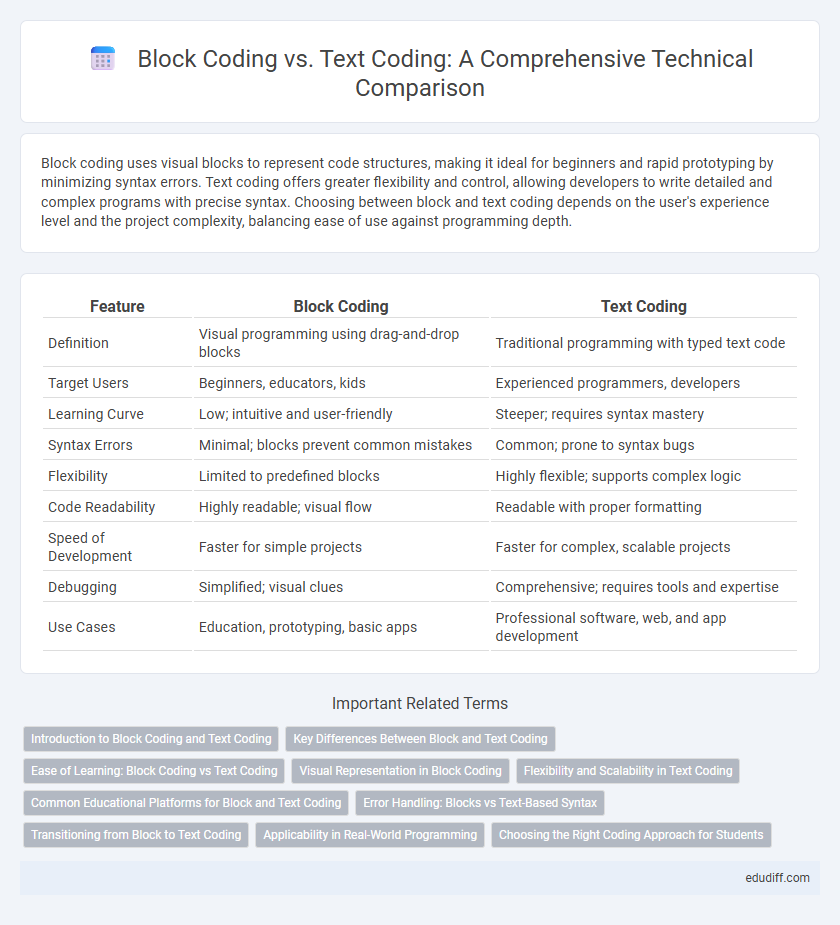Block coding uses visual blocks to represent code structures, making it ideal for beginners and rapid prototyping by minimizing syntax errors. Text coding offers greater flexibility and control, allowing developers to write detailed and complex programs with precise syntax. Choosing between block and text coding depends on the user's experience level and the project complexity, balancing ease of use against programming depth.
Table of Comparison
| Feature | Block Coding | Text Coding |
|---|---|---|
| Definition | Visual programming using drag-and-drop blocks | Traditional programming with typed text code |
| Target Users | Beginners, educators, kids | Experienced programmers, developers |
| Learning Curve | Low; intuitive and user-friendly | Steeper; requires syntax mastery |
| Syntax Errors | Minimal; blocks prevent common mistakes | Common; prone to syntax bugs |
| Flexibility | Limited to predefined blocks | Highly flexible; supports complex logic |
| Code Readability | Highly readable; visual flow | Readable with proper formatting |
| Speed of Development | Faster for simple projects | Faster for complex, scalable projects |
| Debugging | Simplified; visual clues | Comprehensive; requires tools and expertise |
| Use Cases | Education, prototyping, basic apps | Professional software, web, and app development |
Introduction to Block Coding and Text Coding
Block coding uses visual blocks that represent programming constructs, enabling beginners to create programs by snapping these blocks together without syntax errors. Text coding requires writing actual code in programming languages like Python or Java, demanding precise syntax and deeper understanding of language rules. Block coding accelerates learning by abstracting complex syntax, while text coding offers greater flexibility and control for advanced development.
Key Differences Between Block and Text Coding
Block coding uses visual programming elements and drag-and-drop interfaces, making it ideal for beginners and rapid prototyping, while text coding relies on writing lines of syntax in programming languages such as Python or JavaScript, offering greater flexibility and control for complex projects. Block coding limits precision and scalability, whereas text coding allows direct manipulation of code and integration with development tools, facilitating debugging and version control. The key differences hinge on accessibility versus customization, with block coding emphasizing ease of learning and text coding prioritizing advanced functionality.
Ease of Learning: Block Coding vs Text Coding
Block coding offers a visual interface that simplifies programming concepts, making it easier for beginners to understand logical flow and syntax without memorizing complex code. Text coding demands proficiency in specific programming languages, requiring learners to master syntax and structure, which can be challenging for novices. Consequently, block coding accelerates initial learning by reducing syntax errors and cognitive load, while text coding builds deeper coding skills over time.
Visual Representation in Block Coding
Block coding offers a visually intuitive interface where code is represented as interconnected blocks, enabling easier understanding of program flow and logic. This visual representation minimizes syntax errors and enhances learning by allowing users to focus on algorithmic thinking rather than code structure. In contrast, text coding requires familiarity with language-specific syntax and is less accessible for beginners due to its linear and abstract format.
Flexibility and Scalability in Text Coding
Text coding offers greater flexibility and scalability compared to block coding, enabling developers to write complex algorithms with fine-grained control over program flow and data structures. Its syntax-driven environment supports modular code development and integration with numerous libraries, facilitating expansion and maintenance in large-scale software projects. This adaptability makes text coding ideal for applications requiring customized solutions and continuous feature enhancements.
Common Educational Platforms for Block and Text Coding
Common educational platforms for block coding include Scratch, Blockly, and Code.org, which provide intuitive drag-and-drop interfaces ideal for beginners and young learners. Text coding platforms like Repl.it, Visual Studio Code, and GitHub Codespaces support languages such as Python, JavaScript, and Java, offering advanced features for syntax highlighting and debugging. These platforms cater to different skill levels, facilitating a progressive learning curve from visual programming to text-based coding mastery.
Error Handling: Blocks vs Text-Based Syntax
Block coding environments minimize syntax errors by using predefined visual elements that fit together, reducing the likelihood of incorrect code structure. Text-based coding requires precise syntax, where missing semicolons or incorrect indentation lead to compilation failures or runtime errors. Error handling in block coding is more intuitive for beginners, while text coding demands careful debugging and understanding of compiler messages to resolve syntax issues effectively.
Transitioning from Block to Text Coding
Transitioning from block coding to text coding enhances programming flexibility by enabling direct syntax control and advanced debugging capabilities. Mastery of text-based languages such as Python or JavaScript increases efficiency and supports complex algorithm development beyond the limitations of block interfaces. Developing proficiency in text coding opens pathways to industry-standard software development and deeper computational problem-solving skills.
Applicability in Real-World Programming
Block coding offers an intuitive visual interface ideal for beginners and rapid prototyping, particularly in educational settings and simple application development. Text coding provides greater flexibility and control, essential for complex software projects, system-level programming, and large-scale real-world applications. Developers often transition from block coding to text coding to leverage advanced functionalities, optimize performance, and integrate with various libraries and APIs.
Choosing the Right Coding Approach for Students
Block coding offers a visual and intuitive approach ideal for beginners, enabling students to grasp programming logic without syntax errors. Text coding, preferred for advanced learners, fosters deeper understanding of language-specific syntax and enables complex algorithm development. Selecting the right approach depends on students' skill levels, learning goals, and the complexity of the projects they aim to create.
Block Coding vs Text Coding Infographic

 edudiff.com
edudiff.com